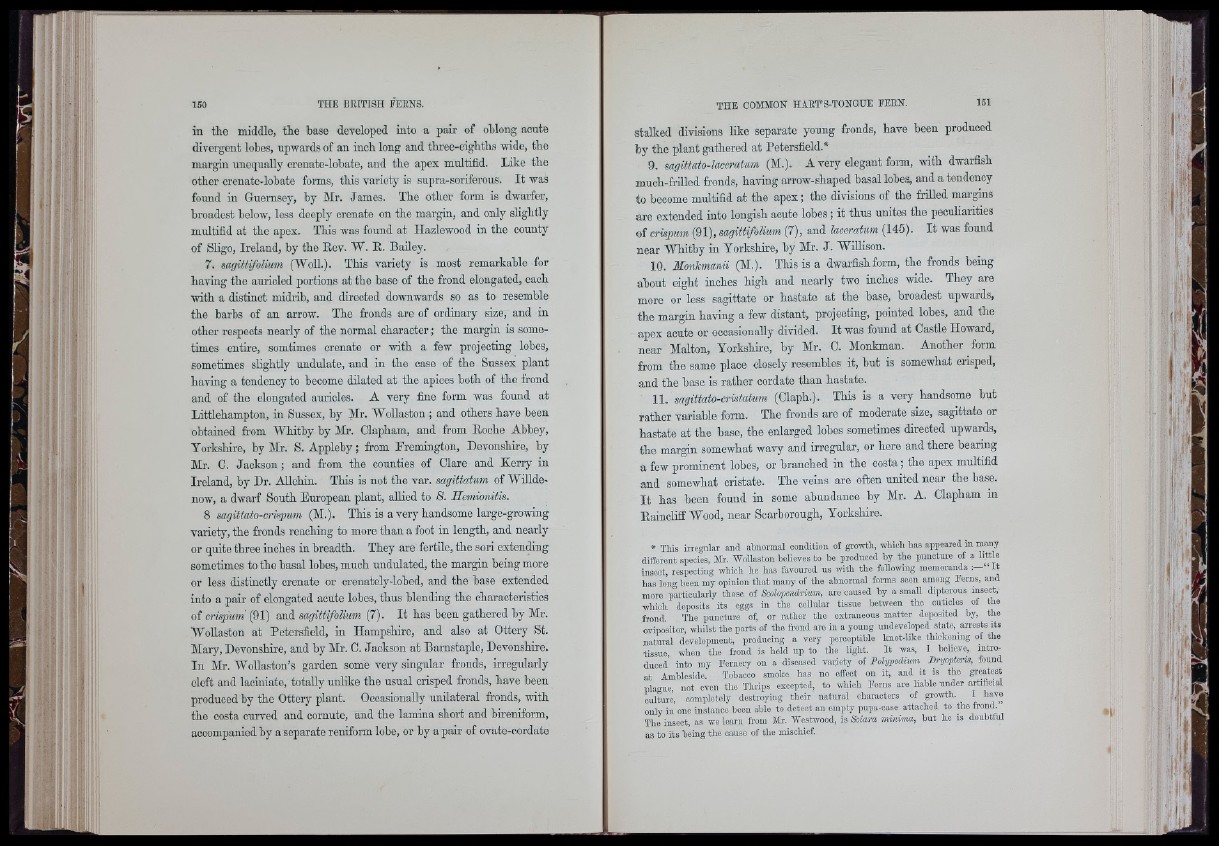
ri
150
in the middle, the base developed into a pair of oblong acute
divergent lobes, upwards of an inch long and three-eighths wide, the
margin unequally crenate-lobate, and the apex multifid. Like the
other cronate-lohatc forms, this variety is supra-soriferous. It was
found in Guernsey, by Mr. James. The other form is dwarfer,
broadest below, less deeply crenate on the margin, and only slightly
multifid at the apex. This was found at Hazlewood in the county
of SHgo, Ireland, by the Eev. W. E. Bailey.
7. sagittifolium (Woll.). This variety is most remarkable for
having the auricled portions at the base of the frond elongated, each
with a distinct midrib, and directed downwards so as to resemble
the barbs of an arrow. The fronds are of ordinary size, and in
other respects nearly of the normal character; the margin is sometimes
entire, somtimes crenate or with a few projecting lobes,
sometimes slightly undulate, and in the case of the Sussex plant
having a tendency to become dilated at the apices both of the frond
and of the elongated auricles. A very fine form was found at
Littlehampton, in Sussex, by Mr. Wollaston ; and others have been
obtained from Whitby by Mr. Clapham, and from Eoche Abbey,
Yorkshire, by Mr. S. Appleby; from Fremington, Devonshire, by
Mr. C. Jackson; and from the counties of Clare and Kerry in
Ireland, by Dr. Allchin. This is not the var. sagittatum of Willdenow,
a dwarf South European plant, aUied to 8. Hemionitis.
8 sagittato-crispum (M.). This is a verj'handsome large-growing
variety, the fronds reaching to more than a foot in length, and nearly
or quite three inches in breadth. They are fertile, the sori extending
sometimes to the basal lobes, much undulated, the margin being more
or less distinctly crenate or crenately-lobed, and the base extended
into a pair of elongated acute lobes, thus blending the characteristics
of crispum' (91) and sagittifolium (7). It has been gathered by Mr.
Wollaston at Petersfield, in Hampshire, and also at Ottery St.
Mary, Devonshire, and by Mr. C. Jackson at Barnstaple, Devonshire.
In Mr. Wollaston’s garden some very singular fronds, irregularly
cleft and laoiniate, totally unlike the usual crisped fronds, have been
produced by the Ottery plant. Occasionally unilateral fronds, with
the costa curved and oornnte, and the lamina short and bireniform,
accompanied by a separate reniform lobe, or by a pair of ovate-cordate
stalked divisions Kke separate young fronds, have been produced
by the plant gathered at Petersfield.*
9. sagittato-laeeratum (M.). A very elegant form, with dwarfish
much-frilled fronds, having arrow-shaped basal lobes, and a tendency
to become multifid at the apex; the divisions of the frilled margins
are extended into longish acute lobes; it thus unites the peouKarities
of crispum (91), sagittifolium (7), and laceratum (145). It was found
near Whitby in Yorkshire, by Mr. J. Wfflison.
10. Monlcmanii (M.). This is a dwarfish form, the fronds being
about eight inches high and nearly two inches wide. They are
more or less sagittate or hastate at the base, broadest upwards,
the margin having a few distant, projecting, pointed lohes, and the
apex acute or occasionally divided. It was found at Castle Howard,
near Maltón, Yorkshire, by Mr. 0. Monkman. Another form
from the same place closely resembles it, hut is somewhat crisped,
and the base is rather cordate than hastate.
11. sagittato-cristatum (Claph.). This is a very handsome but
rather variable form. The fronds are of moderate size, sagittate or
hastate at the base, the enlarged lobes sometimes directed upwards,
the margin somewhat wavy and irregular, or here and there bearing
a few prominent lobes, or branched in the costa; the apex multifid
and somewhat cristate. The veins are often united near the base.
It has been found in some abundance by Mr. A. Clapham m
Eainoliff Wood, near Scarborough, Yorkshire.
* Tliis irregular and abnormal condition of growth, wbich has appeared in many
different species, Mr. WoUaston believes to be produced by th e puncture of a little
insect, respecting which he has favoured us v dth th e following memoranda “ I t
has long been my opinion th a t many of th e abnormal forms seen among Ferns, and
more particularly those of Scolopendrium, are caused by a small dipterous insect,
which deposits its eggs in th e cellular tissue between th e cuticles of th e
frond. The puncture of, or rath er th e extraneous ma tte r deposited by, th e
ovipositor, whilst th e parts of th e frond are in a young undeveloped state, arrests its
n a tu ra l development, producing a very perceptible knot-like thickening of the
tissue, when th e frond is held up to th e light. I t was, I believe, in tro duced
into my Fernery on a diseased variety of Polypodium Dryopteris, found
a t Ambleside. Tobacco smoke has no effect on it, and it is th e greatest
pla<Tue, not even th e Thrips excepted, to which Ferns are liable under artificial
culture, completely destroying th e ir n a tu ra l characters of growth. I have
only in one instance been able to detect an empty pupa-case attached to th e frond.
The insect, as we learn from Mr. Westwood, is Sciara minima, b u t he is doubtful
as to its being th e cause of th e mischief.
It!
i
t | '
1"'
i!
■ ■,!
.4
ilri
■'li;
; Ifl